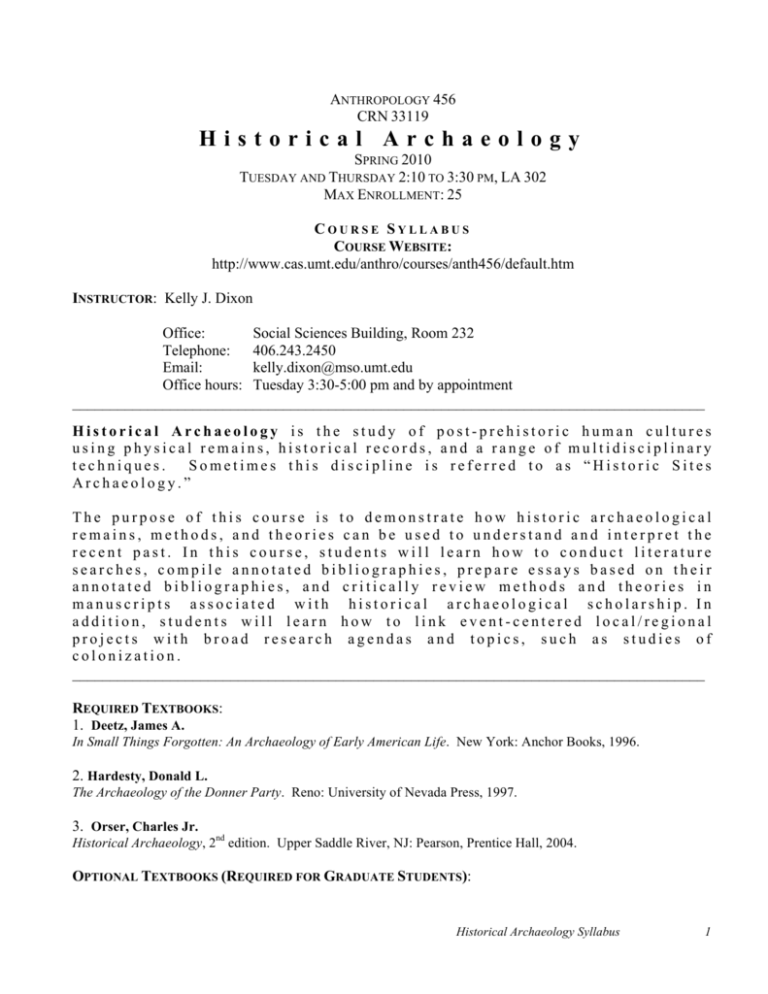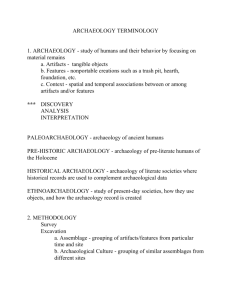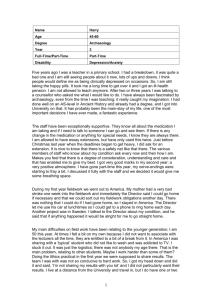
ANTHROPOLOGY 456
CRN 33119
Historical Archaeology
SPRING 2010
TUESDAY AND THURSDAY 2:10 TO 3:30 PM, LA 302
MAX ENROLLMENT: 25
COURSE SYLLABUS
COURSE WEBSITE:
http://www.cas.umt.edu/anthro/courses/anth456/default.htm
INSTRUCTOR: Kelly J. Dixon
Office:
Social Sciences Building, Room 232
Telephone:
406.243.2450
Email:
kelly.dixon@mso.umt.edu
Office hours: Tuesday 3:30-5:00 pm and by appointment
____________________________________________________________________________________
Historical Archaeology is the study of post-prehistoric human cultures
using physical remains, historical records, and a range of multidisciplinary
techniques.
Sometimes this discipline is referred to as “Historic Sites
Archaeology.”
The purpose of this course is to demonstrate how historic archaeological
remains, methods, and theories can be used to understand and interpret the
recent past. In this course, students will learn how to conduct literature
searches, compile annotated bibliographies, prepare essays based on their
annotated bibliographies, and critically review methods and theories in
manuscripts associated with historical archaeological scholarship. In
addition, students will learn how to link event-centered local/regional
projects with broad research agendas and topics, such as studies of
colonization.
____________________________________________________________________________________
REQUIRED TEXTBOOKS:
1. Deetz, James A.
In Small Things Forgotten: An Archaeology of Early American Life. New York: Anchor Books, 1996.
2. Hardesty, Donald L.
The Archaeology of the Donner Party. Reno: University of Nevada Press, 1997.
3. Orser, Charles Jr.
Historical Archaeology, 2nd edition. Upper Saddle River, NJ: Pearson, Prentice Hall, 2004.
OPTIONAL TEXTBOOKS (REQUIRED FOR GRADUATE STUDENTS):
Historical Archaeology Syllabus
1
1. Lawrence, Susan
Dolly’s Creek: An Archaeology of a Victorian Goldfields Community. Melbourne: Melbourne University Press,
2000.
2. Novak, Shannon A. House of Mourning: A Biocultural History of the Mountain Meadows Massacre. Salt
Lake City: University of Utah Press, 2008.
ADDITIONAL READINGS* (POSTED AS PDFS ON COURSE WEBSITE):
Blanton, Dennis
2003 The weather is fine, wish you were here, because I’m the last one alive: “learning” the
environment in the English New World colonies. In Colonization of Unfamiliar Landscapes: The
Archaeology of Adaptation, edited by Marcy Rockman and James Steele, pp. 190-200. Routledge,
London.
Deetz, James A.
1995 Flowerdew Hundred: The Archaeology of a Virginia Plantation, 1619-1864. Charlottesville:
University of Virginia Press (excerpt will be assigned/discussed in class).
Dixon, Kelly J., Shannon A. Novak, Gwen Robbins, Julie M. Schablitsky, G. R. Scott, and Guy Tasa
2010 “’Men, Women, Children Starving’: Archaeology of the Donner Family Camp.” American
Antiquity.
Grayson, Donald
1990 Donner Party Deaths: A Demographic Assessment. Journal of Anthropological Research
46(3):223-242.
Joyce, Rosemary A. and Jeanne Lopiparo
2005 Doing Agency in Archaeology. Journal of Archaeological Method and Theory 12:365-374.
Leone, M.
1982 Some Opinions about Recovering Mind. American Antiquity 47(4):742-760.
Lightfoot, Kent G. and Antoinette Martinez
1995 Frontiers and Boundaries in Archaeological Perspective. Annual Review of Anthropology 24:471-92.
Little, Barbara J.
2009 What Can Archaeology Do for Justice, Peace, Community, and the Earth? Historical Archaeology
43(4):115-119.
Mullins, Paul R.
2008 The Strange and Unusual: Material and Social Dimensions of Chinese Identity. Historical
Archaeology, 42(3):152-157.
Novak, Shannon A. and Lars Rodseth
Historical Archaeology Syllabus
2
2006 Remembering Mountain Meadows: Collective Violence and the Manipulation of Social
Boundaries. Journal of Anthropological Research 61(1):1-25.
Saitta, Dean
1994 Agency, Class, and Archaeological Interpretation. Journal of Anthropological Archaeology 13:201227.
Spude, Catherine Holder
2005 Brothels and Saloons: An Archaeology of Gender in the American West. Historical Archaeology,
39(1):89-106.
Voss, Barbara L. and Rebecca Allen
2008 Overseas Chinese Archaeology: Historical Foundations, Current Reflections, and New Directions.
Historical Archaeology, 42(3):5-28.
*Additional readings may be assigned and discussed throughout the semester; a course bibliography will
be presented to students.
COURSE STRUCTURE:
This course meets for 80 minutes, two days a week, throughout the semester. Class meetings will include
lectures, in-class exercises, films, and visits to lab and archive facilities. Students may be asked to
participate in class by sharing their ideas with the rest of the class in informal discussions and/or in brief
written assignments. We will investigate at least one case study to give students a sense of designing,
carrying out, and publishing the results of an interdisciplinary [historic-period] archaeological project.
Throughout the semester, I may assign readings or handouts not listed in this syllabus; such items will
provide you with the opportunity to examine more specific subjects than those outlined in the required
readings.
GRADING POLICY:
Course grades will be based upon student performance on assignments, or examinations, and a series of
in-class exercises. Graduate students will be responsible for all of the above and book reviews associated
with the optional readings.
POINTS PER ASSIGNMENT:
1st Mid-term Project*
75 points
nd
2 Mid-term Project*
75 points
Final Project*
100 points
In-class exercises
50 points
__________________________________________________
TOTAL
300 points
2 Book Reviews (Graduate Students Only)
200 points
Annotated Bibliography (Graduate Students Only) 100 points
Historical Archaeology Syllabus
3
_________________________________________________
GRADUATE STUDENT TOTAL
600 points (includes undergraduate grading)
I will assign +/- grades for this course and final grades will be based upon the following average scores
for the exams, in-class exercises, and graduate student book reviews: A (100-95), A- (94-90), B+ (89-88),
B (87-83), B- (82-80), C+ (79-78), C (77-73), C- (72-70), D+ (69-68), D (67-63), D- (62-60), F (59 or
less).
* Make-up exams will be given ONLY in cases of verified and unavoidable emergencies. You must
notify me IN ADVANCE if you are unable to take the regularly scheduled exam.
ATTENDANCE:
Attendance will be taken during each class and will help make decisions about a student’s final grade in
borderline cases. Also, the in-class exercises require attendance to get full points.
STUDENTS WITH DISABILITIES:
The Department of Anthropology is committed to equal opportunity in education for all students,
including those with documented physical disabilities or documented learning disabilities. University
policy states that it is the responsibility of students with documented disabilities to contact instructors
DURING THE FIRST WEEK OF THE SEMESTER to discuss appropriate accommodations to ensure
equity in grading, classroom experiences, and outside assignments. The instructor will meet with the
student and the staff of the Disability Services for Students (DSS) to formulate a plan for
accommodations. Please contact Jim Marks in DSS (243.2373, Lommasson Center 154) for more
information.
COURSE SCHEDULE:
Week 1: January 26, 28: Intro to Historical Archaeology?
Assigned Readings
Intro to Historical Archaeology
Orser (Chapters 1-3)
What is Historical Archaeology?; Types of Historical Archaeological Sites (Underwater, Industrial, etc.)
Case Studies (Intro to our “pet” case study of the semester)
Week 2: February 2, 4 What is Historical Archaeology?
People Without History; “Ethnicity and Race”
African American Archaeology
Documentary Study: Slave Island
Assigned Readings
Deetz (pp. 187-211), Orser (pp. 251-261)
Deetz (pp. 212-252)
Week 3: February 9, 11 Research Methods in Historical Archaeology
Assigned Readings
Asian American Archaeology
Voss and Allen, 2008, “Overseas Chinese Archaeology…”;
Mullins 2008, The Strange and Unusual, Historical Archaeology;
Artifacts and Material Culture: Gravestone Art
Deetz (pp. 89-124)
Using Artifacts to Interpret the Past
Orser (Chapter 4)
Deetz (pp. 165-186)
Week 4: February 16, 18 Research Methods in Historical Archaeology
Assigned Readings
How to Get a Date
Orser (Chapter 5)
Pre-fieldwork: Historical Research
Orser (Chapter 7, pp. 171-184)
Case Study: Mountain Meadows
Novak, House of Mourning (optional for undergraduates)
Historical Archaeology Syllabus
4
Documentary Study: What Happened at Mountain Meadows?
GRAD STUDENTS: 1st BOOK REVIEW DUE February 18 (Novak’s House of Mourning)
Week 5: February 23, 25 Interdisciplinary Research: Building Bridges
Assigned Readings
Library Visit: Feb 23 Historical Research (Archives)
Library Visit: Feb 25 Literature Search (Scholarly Databases) and Government Documents
Week 6: March 2, 4 Research Methods in Historical Archaeology
Assigned Readings
Field and Laboratory Work
Orser (Chapters 6 and 8)
Artifact Curation & Artifact Databases
Architecture as Artifact
Orser (pp. 184-190); Deetz (pp. 125-164)
Week 7: March 9, 10 Explanation in Historical Archaeology
Assigned Readings
Theoretical Paradigms
Orser (Chapter 9)
History of Theoretical Explanation in Historical Archaeology
How is Theory Reflected in Historical Archaeological Research?
Feminist Theory and Engendered Archaeologies
Spude, 2005, “Brothels and Saloons…”, Historical
Archaeology
Agency: Theory, Fad, Product of the Environment…
Joyce and Lopiparo, 2005, Doing Agency in Archaeology,
Journal of Archaeological Method and Theory
Week 8: March 16, 18 Colonization, Cultures in Contact, and Events
Assigned Readings
An Event-Centered Approach to Archaeology Beck et al. 2007, “Eventful Archaeology,” Current Anthropology
Class, Capitalism, and Culture Change
Orser (Chapter 10)
Globalization and the Archaeology of Frontiers
Orser (Chapter 11)
Lightfoot and Martinez, 1995, “Frontiers and Boundaries…”
Annual Review of Anthropology
Colonization of Unfamiliar Landscapes
Blanton, 2003 “The weather is fine, wish you were here…”
Mid-term Project 1: Annotated bibliography (due March 23)
Week 9: March 23, 25 Interdisciplinary Case Study
Case Study: Donner Party
Assigned Readings
Hardesty, Archaeology of the Donner Party
Grayson, 1990, “Donner Party Deaths…”, Journal of Archaeological Research
Dixon et al. 2010, “Men, Women, Children: Starving,” American Antiquity
Week 10: March 30, April 1 ____________________________________________________________
NO CLASS – SPRING BREAK
Week 11: April 6, 8 Historical Archaeology in the American West
Assigned Readings
Case Study: Donner Party
Excerpts from Dixon et al. Anthropology of Desperation, forthcoming
Mid-term Assignment
Week 12: April 13, 15 The American West: Special Topics
Assigned Readings
Case Study: Donner Party
Excerpts from Dixon et al. Anthropology of Desperation, forthcoming
Mid-term Project 2: Review of Manuscript (method and theory critique) (due April 20)
Historical Archaeology Syllabus
5
Review of readings, discussions of final projects
Week 13: April 20, 22 Historical Archaeology and the American West
Archaeologies of the American West: A Regional Approach
Review of readings, discussions of final projects
Assigned Readings
to be announced
to be announced
Week 14: April 27, 29 Historical Archaeology: Applying the West to the World
Assigned Readings
The wild outback?
Lawrence, Dolly’s Creek (optional for undergraduates)
GRAD STUDENTS: 2nd BOOK REVIEW DUE April 27
An Archaeology of Early America
Deetz, In Small Things Forgotten
Deetz, Flowerdew Hundred (excerpt)
Discussions of final projects/essays
Week 15: May 4, 6 Academic and Applied? The Role of Historical Archaeology
Assessing Site Significance
Presentation of final projects
Assigned Readings
Orser (Chapter 12)
Week 16: FINALS WEEK
Final Exam Time Slot: Thursday, May 13, 1:10-3:10
_________________
Historical Archaeology Syllabus
6








